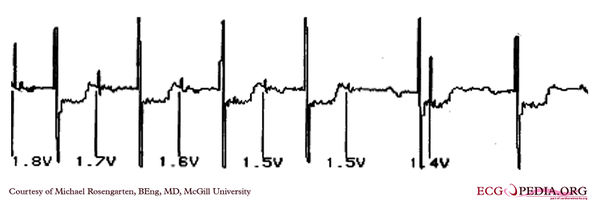McGill Case 290
| This case report is kindly provided by Michael Rosengarten from McGill and is part of the McGill Cases. These cases come from the McGill EKG World Encyclopedia.
|

The cardiogram illustrates the determination of the atrial capture threshold. The pacemaker is decrementing down the atrial amplitude as marked below the atrial pacer spikes. note the loss of atrial capture after the second spike of 1.5 volts. Loss of capture is illustrated by three events, 1) the lack of a p wave after the spike, 2) the appearance of a native p wave after the failure to capture and 3) the change in the RR intervals as the QRS is no longer following the paced P wave. The lack of capture after the second 1.5 volt complex illustrates a component of time dependent capture where after a while a stimulus may fail to capture even thought the amplitude is kept constant.
